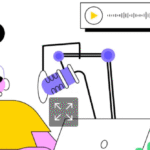Mobile apps have become essential to modern life. From health monitoring to financial transactions, mobile apps shape daily experiences. According to Statista, mobile apps generated over $500 billion in revenue globally in 2023. Another report by Data.ai predicts the total time spent in mobile apps will exceed 6 trillion hours annually by 2030. Given this trajectory, any competitive mobile app development company must plan for how mobile apps will evolve over the next decade.
Current Landscape: Where We Stand
Mobile app development has matured in recent years. Today, apps offer high-speed performance, offline capabilities, and real-time data integration. However, shifts in hardware, AI, and user behavior will significantly change mobile apps by 2035.
Key characteristics of today’s mobile apps include:
- Native or hybrid frameworks (e.g., Swift, Kotlin, Flutter)
- Centralized cloud storage and APIs
- User-focused design principles
- Cross-platform compatibility
But the next decade promises deeper integration, smarter automation, and more decentralized architecture.
AI-Driven Personalization Will Become Default
Artificial intelligence already enhances recommendations in media, shopping, and social media apps. Over the next 10 years, AI will be integrated as a core engine of mobile app personalization.
Expected Developments:
- AI models trained on user behavior will customize every interaction
- Apps will adapt interfaces based on user mood or context
- Predictive features will automate user tasks
Example:
- A travel booking app could predict a user’s ideal trip using weather data, past bookings, and spending habits
Mobile app development companies must start integrating flexible machine learning frameworks, such as TensorFlow Lite, into their builds.
Augmented Reality (AR) and Mixed Reality (MR) Will Become Standard
AR and MR have moved beyond gaming and entertainment. Future mobile apps will use them for commerce, healthcare, education, and training.
Use Cases That Will Expand:
- AR-based virtual try-ons for retail
- MR tools for remote surgeries and diagnostics
- Interactive educational content for K-12 and higher education
Stat Snapshot:
- According to PwC, AR and VR could contribute over $1.5 trillion to the global economy by 2030.
Developers will increasingly rely on toolkits like ARKit and ARCore. Mobile app development companies should invest in 3D design and spatial computing skills.
Cross-Platform Development Will Dominate
Cross-platform frameworks are improving in performance and versatility. This trend will continue as companies aim to reduce costs and time-to-market.
Benefits of Cross-Platform Frameworks:
- Reusable code across platforms (Android, iOS, Web)
- Easier maintenance and updates
- Consistent user experiences
Emerging Technologies:
- Flutter 5.x
- React Native with Fabric Renderer
- Kotlin Multiplatform
A reliable mobile app development company will use these tools to deliver efficient and scalable solutions.
Edge Computing Will Replace Cloud Reliance
Cloud computing powers most apps today. However, edge computing—processing data near the source—will become more common to reduce latency.
Edge Advantages:
- Real-time data processing
- Enhanced privacy and data sovereignty
- Reduced dependence on remote servers
Examples of Use:
- Autonomous vehicles analyzing sensor data locally
- Fitness apps processing health metrics on-device
Mobile app development companies will need to understand edge hardware requirements and design low-latency applications.
Progressive Web Apps (PWAs) Will Become More Common
PWAs combine the best of web and mobile apps. They work offline, load quickly, and don’t require installation from an app store.
Why PWAs Will Rise:
- Lower development costs
- Easy updates
- Better accessibility in low-bandwidth regions
Industries That Benefit:
- E-commerce
- News and content platforms
- Educational portals
With enhanced service worker APIs and better browser support, PWAs are set to expand in reach and capability.
Privacy-First Architecture Will Be Mandatory
Consumers and regulators are demanding better data privacy. Apps in the next decade will prioritize secure architecture and transparency.
Key Privacy Trends:
- On-device data processing
- Consent-driven data usage
- End-to-end encryption for all transactions
Global Regulations Influencing This Shift:
- GDPR (Europe)
- CCPA (California)
- DPDP (India)
Any mobile app development company ignoring these requirements will risk user attrition and regulatory penalties.
Decentralized Apps (dApps) Will Find Wider Adoption
Blockchain and distributed ledger technologies will support more mobile apps in finance, logistics, and identity management.
Advantages of dApps:
- Tamper-proof data
- Transparent operations
- Enhanced security and auditability
Possible Implementations:
- Mobile wallets with built-in DeFi features
- Identity verification using blockchain credentials
DApps require new development stacks and a deep understanding of consensus algorithms, smart contracts, and gas optimization.
Voice Interfaces Will Rival Touch
Voice will become a major user interface alongside touch and gestures. Natural language processing will improve user interaction and accessibility.
Growth Factors:
- Higher voice recognition accuracy
- Widespread smart speaker adoption
- Increased accessibility requirements
Real-World Applications:
- Banking apps using voice-based authentication
- Productivity tools offering voice-driven commands
Mobile app development companies must design voice-first interactions and integrate APIs like Google Dialogflow and Amazon Lex.
Real-Time Collaboration Features Will Be Ubiquitous
Remote work and hybrid environments are now standard. Apps will evolve to support real-time collaboration across devices and teams.
Key Features to Expect:
- Simultaneous document editing
- Shared dashboards and chat integration
- AR-based collaborative interfaces
Tools and APIs Involved:
- WebRTC for real-time communication
- Firebase for real-time databases
- Socket.IO for bidirectional event communication
Mobile app developers must optimize network handling and latency control.
Integration with Wearables and IoT Will Deepen
Mobile apps will serve as control hubs for a growing number of wearables and IoT devices.
Examples of Deep Integration:
- Smart home apps linking appliances, lighting, and security
- Health apps syncing with smartwatches, glucose monitors, and ECG devices
Industry Growth:
- IDC reports that global shipments of wearable devices will reach over 650 million units by 2028
App developers will require knowledge of IoT protocols (MQTT, CoAP) and device SDKs.
The Role of Mobile App Development Companies
As these trends unfold, mobile app development companies must evolve. They will act not just as developers but as consultants, strategists, and integration experts.
Skills Future Developers Must Cultivate:
- AI and ML integration
- Edge and decentralized architecture design
- Cross-platform UI/UX strategy
- Real-time communication protocols
Client Expectations Will Shift Toward:
- Faster time to market
- Transparent data practices
- Inclusive and accessible design
Those who adapt will thrive. Those who cling to outdated models will fall behind.
Conclusion
The mobile app landscape is poised for massive transformation. From AI-driven personalization to decentralized architectures and real-time collaboration, the evolution will touch every aspect of app development. A forward-thinking mobile app development company must understand these shifts, train their teams accordingly, and prepare for a world where mobile experiences are more intelligent, immersive, and interconnected.
In the coming decade, the question will no longer be whether an app works—but whether it thinks, adapts, and respects user privacy.
- How Mobile Apps Will Evolve Over the Next 10 Years | Insights by a Leading Mobile App Development Company
- Explore how mobile apps will transform over the next decade with insights from a top mobile app development company. Discover future trends in AI, AR, cross-platform development, edge computing, and more.
- mobile app development, future of mobile apps, mobile app trends 2035, AI in mobile apps, AR in apps, edge computing, cross-platform development, wearable integration, mobile app security, mobile app development company, voice interfaces, decentralized apps, PWAs, mobile UX trends
Related posts:
 Used Mobile in Dubai: Your Ultimate Guide to Buying Quality Phones at Affordable Prices
Used Mobile in Dubai: Your Ultimate Guide to Buying Quality Phones at Affordable Prices
 How a Mobile App Development Company in India Drives Innovation for Your Business
How a Mobile App Development Company in India Drives Innovation for Your Business
 Branded SMS Marketing in Karachi: Reach Customers with a Personal Touch
Branded SMS Marketing in Karachi: Reach Customers with a Personal Touch
 Android App Development: A Complete Beginner-to-Expert Guide
Android App Development: A Complete Beginner-to-Expert Guide
 PikaShow APK: Stream Free Movies, TV Shows, Sports & Live TV on Android
PikaShow APK: Stream Free Movies, TV Shows, Sports & Live TV on Android
 Why Hiring a Mobile App Development Company is Better Than Building In-House
Why Hiring a Mobile App Development Company is Better Than Building In-House
 Is Tablet Screen Repair Service Different from Smartphone Repair?
Is Tablet Screen Repair Service Different from Smartphone Repair?
 What is the Role of Hindi Translation Services in Digital Localization?
What is the Role of Hindi Translation Services in Digital Localization?






